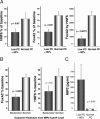FoxA2 involvement in suppression of protein C, an outcome predictor in experimental sepsis
- PMID: 16522789
- PMCID: PMC1391958
- DOI: 10.1128/CVI.13.3.426-432.2006
FoxA2 involvement in suppression of protein C, an outcome predictor in experimental sepsis
Abstract
Low levels of protein C (PC) predict outcome as early as 10 h after insult in a rat polymicrobial sepsis model and were associated with suppression of PC mRNA, upstream transcription factor FoxA2, and cofactor hepatocyte nuclear factor 6 (HNF6). Small interfering RNA suppression of FoxA2 in isolated hepatocytes demonstrated regulation of both its cofactor HNF6 and PC. Our data suggest that reduced FoxA2 may be important in the suppression of PC and resulting poor outcome in sepsis.
Figures




References
-
- Angus, D., W. T. Linde-Zwirble, J. Lidicker, G. Clermont, J. Carcillo, and M. R. Pinsky. 2001. Epidemiology of severe sepsis in the United States: analysis of incidence, outcome, and associated costs of care. Crit. Care Med. 29:1303-1310. - PubMed
-
- Arias, I., W. Jacoby, H. Popper, et al. 1988. The liver: biology and pathobiology, 2nd ed. Raven Press, New York, N.Y.
-
- Berg, D. T., L. J. Myers, M. A. Richardson, G. Sandusky, and B. W. Grinnell. 2005. Smad6s regulates plasminogen activator inhibitor-1 through a protein kinase C-beta-dependent up-regulation of transforming growth factor-beta. J. Biol. Chem. 280:14943-14947. - PubMed
-
- Bernard, G., J. Vincent, P. Laterre, S. LaRosa, J. Dhainaut, A. Lopez-Rodriguez, J. Steingrub, G. Garber, J. Helterbrand, E. Ely, and C. Fisher. 2001. Efficacy and safety of recombinant human activated protein C for severe sepsis. N. Engl. J. Med. 344:699-705. - PubMed
-
- Brueckmann, M., U. Hoffmann, L. De Rossi, H. M. Weiler, V. Liebe, S. Lang, J. J. Kaden, M. Borggrefe, K. K. Haase, and G. Huhle. 2004. Activated protein C inhibits the release of macrophage inflammatory protein-1-alpha from THP-1 cells and from human monocytes. Cytokine 26:106-113. - PubMed
MeSH terms
Substances
LinkOut - more resources
Full Text Sources
Medical
Molecular Biology Databases

